By Mark Penn, Chairman and CEO, Stagwell
CONTACT
hello@stagwellglobal.com
FEATURING
Marketing Frontiers is a new series from Stagwell exploring the methods, mediums, and messes modern marketers will grapple with over the next decade as they chart transformation in the discipline. This February, Stagwell is exploring NFTs.
NFTS are an opportunity brands shouldn’t pass on.
Two strategies are driving value: incentivizing real-world action with NFTs, and using them to build loyal long-term consumer segments.
In the old days, marketing companies incentivized consumers with free toasters. Today, they give you an NFT, a digital good that may be even more useful. It’s easy to confuse the NFT craze with other emerging new technologies but they stand apart as offering several unique areas of potential value. First, they provide individually usable coupons or discounts that can be tracked; Second, they offer permanent digital copies of paper goods; and third, they offer collectible opportunities that could soar in value,
Brands want to experiment with NFTs but are struggling to determine whether it’s a fad or an effective long-term brand strategy. They must balance wanting to be first movers on exciting new tech that is racking up serious investment while pursuing virtual items as ways to connect digital and in-person experiences. But barriers make this investment difficult, including the expensiveness inherent in producing some types of NFTs, the wild fluctuation in selling prices, and the knowledge gap among consumers who are confused or otherwise skeptical about the technology.
While it’ll be a while before we can gauge the long-term impact of the NFT activations in the market now, it’s clear from early experiments that two styles of NFT activations are proving successful: those that connect digital incentives to real-world action, and those that help build long-term, loyal consumer segments for brands – either within or beyond their usual consumer base. Sports marketers and luxury fashion brands are leading the charge on effective NFT adoption.
NFTs are too important of an opportunity for today’s brands to pass on.
Incentivizing and Rewarding Real-World Action: Sports Brands
This Super Bowl, the NFL and Ticketmaster are partnering to provide in-person spectators free NFTS that commemorate their tickets and serve as digital keepsakes, giving an added boon to die-hard fans for their commitment to filling stadiums and solving for consumers who want a souvenir from the experience but are prone to losing ticket stubs. In addition to the free, wide-cast NFTs, a set of limited-edition tokens will be released to commemorate past Super Bowls hosted in the city of Los Angeles.
Giving consumers something meaningful for attending in-person events that taps into fandoms, hometown loyalty, and the desire to remember exciting experiences is one avenue of common-sense NFT adoption. These are not the flashy, expensive digital art being auctioned the NFT world is known for, but affordable, scaled and tied directly to an activity that fans have already shown engagement with: collecting stubs. These efforts teach a simple lesson about how to forge new paths with emerging technology: don’t reinvent the wheel; look for ways NFTs enhance or supplement existing real-world action.
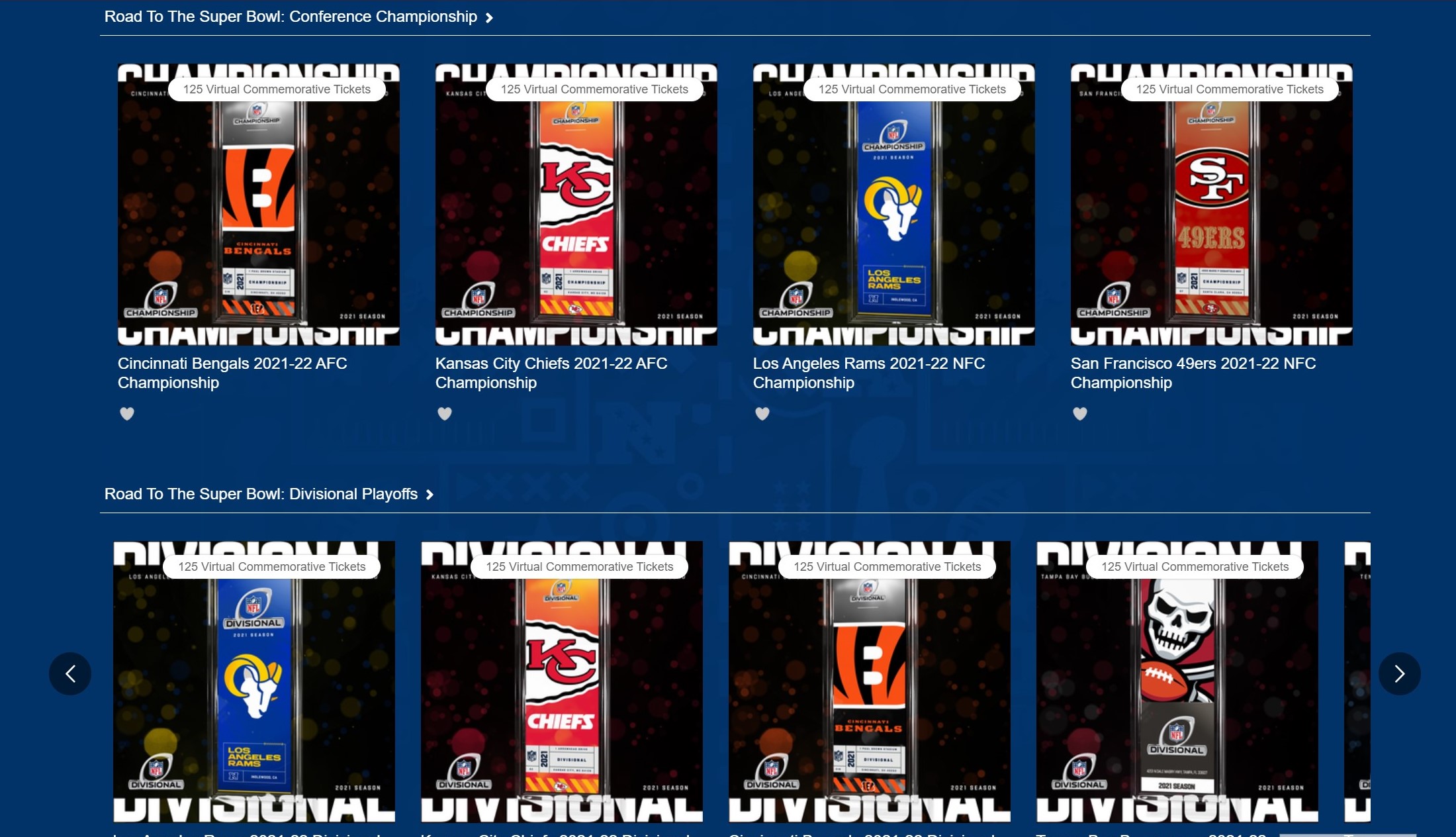
A screenshot of the N.F.L.’s Virtual Marketplace for NFTs and other collectibles.
Building Loyal Long-Term Consumer Segments: Luxury Fashion and Apparel Brands
NFL/Ticketmaster’s effort doubles as a window into how NFTs are tapping into supercharged fan bases to build long-term, loyal consumer segments. Beyond sports, luxury fashion brands use NFTs to engage up-and-coming, nascent consumer segments and prime them for long-term engagement. Louis Vuitton rolled out an adventure game commemorating its founder’s 200th anniversary birthday, featuring a selection of hidden NFTs and a set of ultimate prizes tied to exclusive, real-world offerings. And this year, NYFW goes virtual – presented by Decentraland, the popular Metaverse destination. Decentraland will host a digital component to NYFW that includes runway shows and immersive experiences, branded NFT collections, and other collectibles and digital tokens. These efforts engage a younger set of consumers who may not yet have the disposable income for luxury material purchases in real-life but are attracted to the exclusiveness of the brand and excited for the digital follow-through.
We think NFT’s are too important an opportunity for today’s brands to take a pass on. We believe every brand needs to play in the space in coming years and integrate NFTs into their campaigns. Fans want digital assets of their favorite players; traceable coupons make great targeted assets to enhance customer experience; and everyone loves to collect something that could be valuable.
Sign up to receive more insights from Stagwell and follow us on LinkedIn to stay abreast of news, work, and perspectives from our global network.
Related
Articles
Investments & Financials, Press Releases
May 08, 2024
Stagwell Inc. (STGW) Reports Equity Inducement Grants Under Nasdaq Listing Rule 5635(c)(4)
Stagwell Inc. announced today the grant of equity inducement awards.
Data, In the News, Press Releases
May 07, 2024
New Study by Stagwell’s (STGW) The Harris Poll: New Yorkers are Worried about the Waste Crisis but Don’t See a Plastic Ban as a Solution
Survey found that plastic plays an important role in the…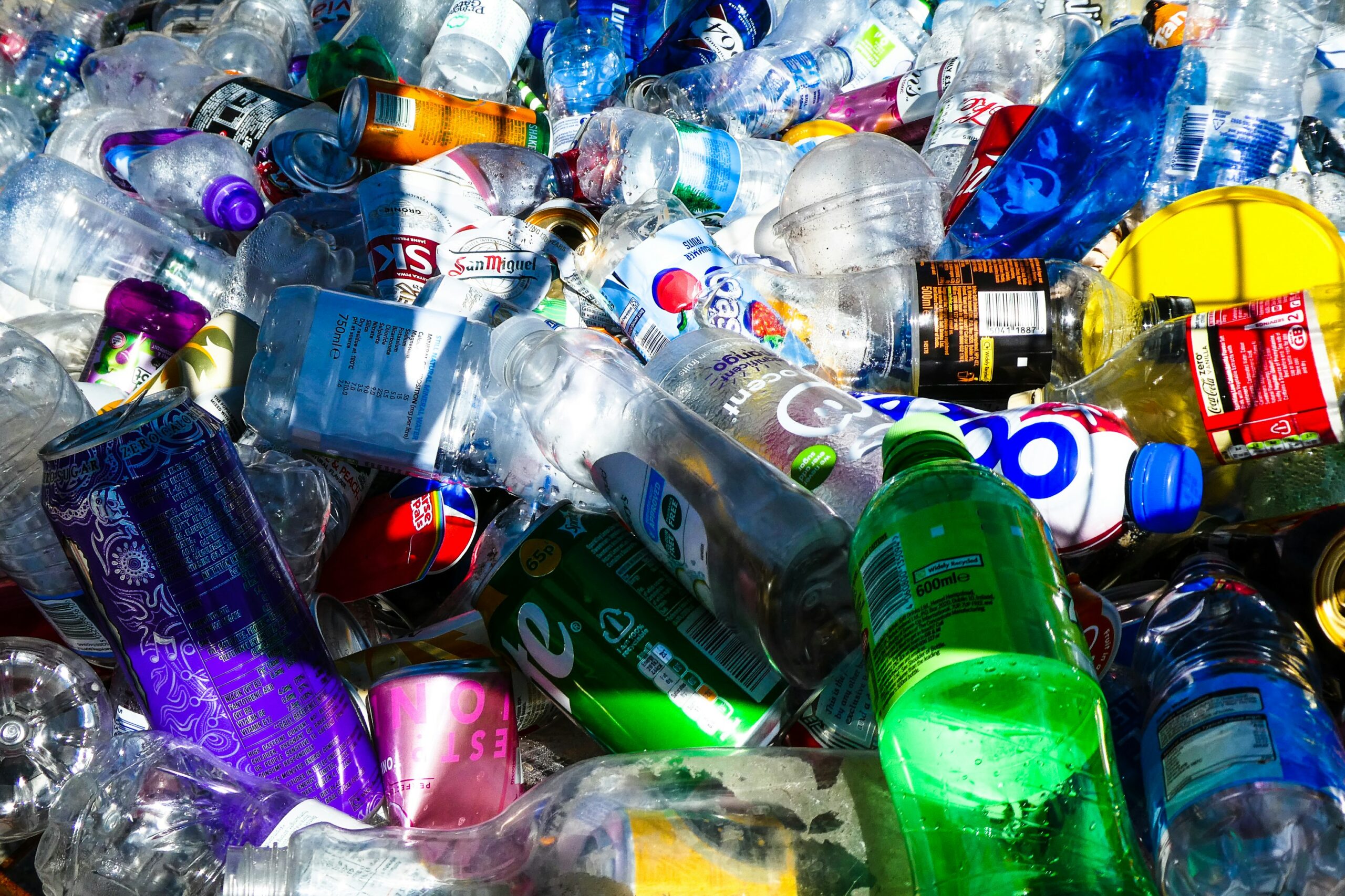
In the News, Press Releases, Stagwell Marketing Cloud, Talent & Awards
May 06, 2024
PRophet, a Stagwell (STGW) Company, Takes Home Two Big Wins at the 2024 Innovation SABRE Awards and 28th Annual Webby Awards
PRophet's AI-driven platform clinches two prestigious awards for innovation and…
Newsletter
Sign Up
These days, good Super Bowl marketing is about more than the ad you run during the big game. Digital marketing’s rise emphasizes creative, omnichannel efforts that leverage emotional resonance and new storytelling mediums to drive business impact. Four key evolutions are changing the ways brands tackle this football tentpole:
- New Definitions of “Super Bowl Campaigns” leave brand marketers to ask: how do I run a Super Bowl campaign that’s more than just the ad?
- New Experiments in Cutting Edge Tech driving powerful new creative dimensions to the consumer experience at and around The Big Game
- New Challengers joining the ranks of advertisers as digital levels the playing field of who can afford to make magic out of a Super Bowl moment
- New Platforms Driving Importance of Social in the ever-evolving Big Game media and content mix.

1. New Definitions of Super Bowl Campaigns
Last year, for the first time since 1983, Anheuser-Busch decided to sit its iconic beer brand Budweiser out of the Super Bowl ad inventory, instead donating the money it would have spent on the ad to support coronavirus vaccination awareness efforts. Stagwell global communications agency Allison+Partners supported the media effort, a strong case study in how you can lead the Super Bowl discourse without appearing in the game. Headlines called the brand a “winner” for the purposeful pivot, and the effort went on to win several effectiveness awards.
While not every brand will find a pivot that works as well, digital marketing is pushing many to consider alternative ways to get Super Bowl ad value without the ad investment. Stunts tied to the game are one approach, but simpler digital activations and content that link brand identity to the underlying currents of sports fandom and entertainment can be winning strategies. See 72andSunny and Tillamook County Creamery’s experiment this year with a shoppable music video released to commemorate National Cheddar Day and the Super Bowl sharing a date on February 13.
2. New Challengers
The Big Game is a whopper investment. The sticker price for spots this year broke records, hitting as high as $7M for some ad inventory. While securing a prime-time spot can wreak ruin on marketing budgets, newer faces have taken to the field in recent years, as digital marketing tools level the playing field for the type and scale of brands that can derive halo value from the Big Game. D.T.C. and e-commerce are flooding the annual roster, with cheeky online retailers like Vroom and other digital natives like DoorDash using it as a platform to scale beyond niche beginnings. Expect the roster to continue diversifying each year, bringing newer, challenger brands to the fore while pushing legacy staples to re-evaluate whether a multi-million dollar spot is the best avenue to drive sustained marketing impact.
3. New Experiments in Cutting Edge Tech
While S.B. viewers will undoubtedly be distracted by digital platforms during the game, the audience remains comparatively rapt in attention during ad breaks, giving brands a solid audience for testing splashy, transformative technology. In recent years, the N.F.L. has run the play on this in partnership with Stagwell creative agency 72andSunny, first by pulling off the game’s first-ever live ad integration transitioning from pre-recorded spot footage to an on-the-field activation. The following year they upped the ante and, well, raised the dead, using holographics, 3D projections, and more to resurrect legendary football coach Vince Lombardi for a resonant message about resilience. This year, Meta is using the Super Bowl as an opportunity to engage consumers on the metaverse technology already available to them via mixed-reality.
As a tactic for driving social conversation the day and week after the Big Game, activations that wield emerging technology to do new, exciting, and yet-untested feats of creativity can be powerful for brands at the Big Game. Aligning experimentation with your product suite, the frontiers of new technology your brand is eager to own, and consumers’ stated interest in the tech will be essential for brands moving forward.
4. New Platforms Driving the Importance of Social
Today’s marketers know this well: it’s no longer about making the right 2-3 assets for a campaign, you need thousands of assets that can cut across social platforms, search, banner, paid, earned, out of Home, and more to amplify your brand’s big game message. At the same time, S.B. advertising is no longer about the crowning jewel of the main campaign film: a dizzying array of shorter cuts, social-specific content, and other branded assets must be prepared to swarm digital channels and amplify the brand’s key messaging.
Social only continues to rise as an essential part of this mix. Close to half of Super Bowl viewers plan to interact on social media during the game, per The Harris Poll/Haven, suggesting advertisers could benefit significantly from the extended post-game conversation on content that makes waves during the game. Marketers should think holistically about the type and mix of content and media needed to drive results.
The Bottom Line
The playbook for what drives value for brands at The Big Game is evolving with new digital tools and alternatives to significant ad investment. This will continue to attract more brands to consider how they can capitalize on the marketing potential of the Big Game while emerging technology will start to reshape the nature of the advertising activations we see each year. Marketers: as you enjoy the excitement of Super Bowl LVI, search for and identify ways brands are making the most out of new formats for social and digital content. Challenge your teams to think beyond the Super Bowl ad to the marketing magic possible when the moment is met with a modern approach to brand marketing.
Follow Stagwell on LinkedIn to keep up with the latest insights from our team.
Related
Articles
Augmented Reality, In the News, Marketing Frontiers
Apr 26, 2024
Legacy Brand, Meet Next-Gen Commerce: Bomb Pop Takes Roblox
Bomb Pop is the most popular ice pop that nobody…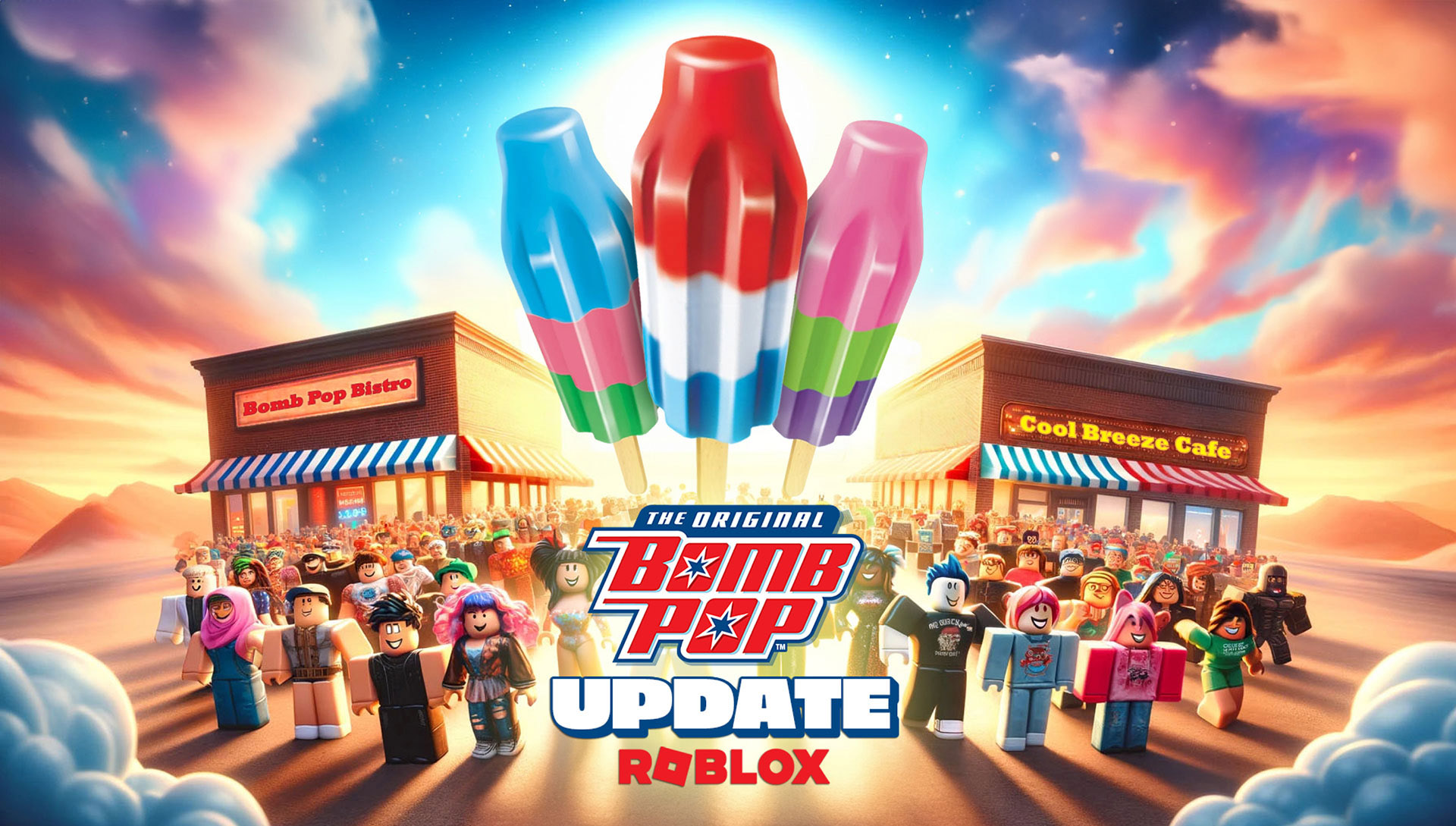
Artificial Intelligence, In the News
Apr 25, 2024
Embracing Comfort Unapologetically with First-Ever AI-Powered La-Z-Boy ‘Decliner’
Building the first-ever AI-powered recliner for the brand that invented…
Augmented Reality
Apr 25, 2024
Playfully Navigating the Google Booth at CES
Google partnered with Left Field Labs to blend its physical…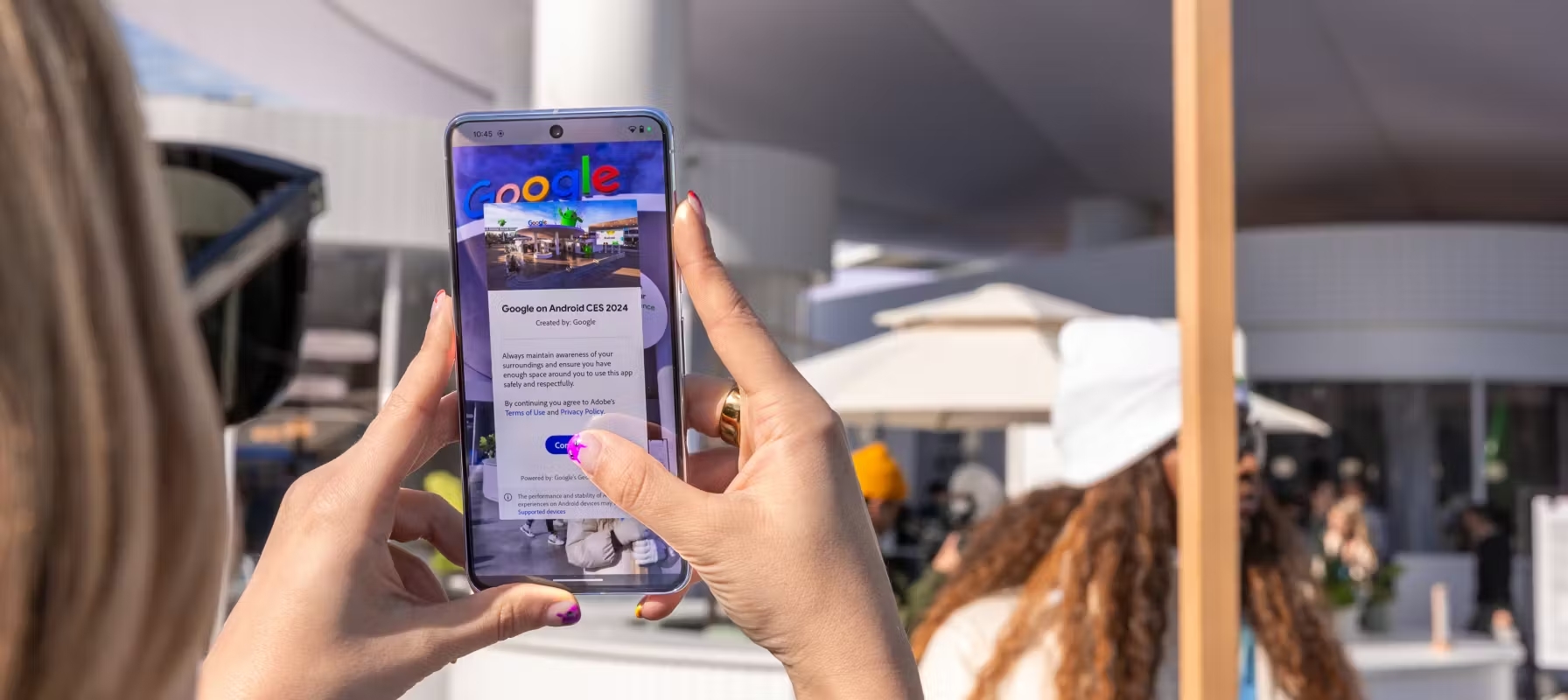
Newsletter
Sign Up
CONTACT
hello@stagwellglobal.com
SIGN UP FOR OUR INSIGHTS BLASTS
By Josh Beatty, Founder, ARound
Early reactions to Miller Lite’s “Meta Lite Bar” experience – where it will offer virtual beer, games, and a chance to view what would have been its Big Game spot –prove there’s work needed to convince the masses that the Metaverse matters. Steve Colbert ripped into the idea: “Man, I love commercials, but I wish I had to work harder to access them while my avatar drinks this imaginary can of carbonated disappointment.”
While some of his riff is just late-night chum, there are insights about how brands should approach the Metaverse, mixed-reality, and emerging tech that consumers are just beginning to identify and understand. Colbert’s points are top of mind for everyone as big ideas for virtual storefronts, fully immersive VR experiences, and digital avatar ecosystems fill the news.
Two parts of Colbert’s criticism for brands to unravel:
- “Work harder to access” – This is going to be a big barrier to early adoption of Metaverse tech. If consumers don’t find it easy to access brand experiences, they won’t engage. While conditioned consumer behavior is the hardest thing in the world to change (when did you last download an app for something?), the only thing stronger than conditioned behavior is a change to one’s environment. Experiments in AR and mixed-reality, especially powered by mobile, can disrupt and captivate consumers in a memorable and meaningful way. Shared environments with low barriers to access will drive value in this space.
- “While my avatar drinks this imaginary can of carbonated disappointment.” The Metaverse is a shared experience, but virtual reality can be isolating. AR and other tech that allows for shared social experiences will connect us to people and places in exciting and fun ways. While the idea of drinking a digital beer may leave people scratching their heads, if the metaverse dive bar that Miller Lite unveils during the Big Game includes a compelling array of shared content and experiences, the fun consumers are having together in this space will eclipse their initial confusion at the premise.
Many brands will try their hands at Metaversal tech in the coming months. Marketers should learn from early consumer/social reactions to experiments underway at the Big Game and proactively work to solve some of the barriers of consumer adoption in this exciting new space.
Related
Articles
Augmented Reality, In the News, Marketing Frontiers
Apr 26, 2024
Legacy Brand, Meet Next-Gen Commerce: Bomb Pop Takes Roblox
Bomb Pop is the most popular ice pop that nobody…
Artificial Intelligence, In the News
Apr 25, 2024
Embracing Comfort Unapologetically with First-Ever AI-Powered La-Z-Boy ‘Decliner’
Building the first-ever AI-powered recliner for the brand that invented…
Augmented Reality
Apr 25, 2024
Playfully Navigating the Google Booth at CES
Google partnered with Left Field Labs to blend its physical…
Newsletter
Sign Up
Originally released on
LOS ANGELES, Jan. 24, 2022 /PRNewswire/ — Today, Brand Innovators, the largest community of brand marketers, have announced their fifth annual Sports Marketing Upfronts presented by 72andSunny and hosted at the Porsche Experience Center in Los Angeles (19800 South Main Street, Carson), Tuesday-Thursday, February 8-10, 2022.
The three-day summit will bring together marketing executives from Fortune 500 and other leading brands ahead of the big game to learn and share how they are leveraging the intersection of sport and entertainment to drive business results in an ever-changing landscape. Current brands featured include: Anheuser-Busch InBev, Bose Corporation, Chipotle Mexican Grill, FanDuel, Nationwide, PepsiCo, United Airlines, and many more! ️
“We are so excited for the latest edition of The Brand Innovators Sports Marketing Summit in LA, featuring the ‘who’s who’ of senior marketers and industry leaders from the NFL and brands like AB InBev, PepsiCo, Frito-Lay, Microsoft, Nationwide, Danone, EA Sports, State Farm, and many more,” said David Teicher, Chief Content Officer, Brand Innovators. “We are bringing the community together to tackle the latest and most innovative sports marketing and sponsorship efforts, and the most important topics, challenges, and opportunities facing the industry today, as marketers continue to strive for ever-elusive cultural relevance.”
“With one of (if not the most) entertaining sporting events of the year held in our backyard, it felt only fitting to collaborate with industry creators and marketers to celebrate innovation,” said Damaune Journey, Global Chief Growth Officer, 72andSunny. “As an agency that believes in creativity that wins and diverse points of view, we are thrilled to be this year’s leading sponsor and to showcase those at the forefront of game-changing ideas.”
“Across every sector, marketing is transforming, driven by new consumer behaviors, needs and emerging technologies. Stagwell’s agencies have a long track record of helping brands innovate at the big game, often setting the year’s agenda for creative brand marketing,” said Stagwell Chairman and CEO Mark Penn. “We’re proud to partner with Brand Innovators and 72andSunny this year to discuss the marketing transformations underway.”
The summit will be a hybrid event with in-person programming reserved exclusively for qualified brand-side marketers and active paying sponsors. The summit will also be made available virtual to the public. Attendees may register at brand-innovators.com.
About Brand Innovators:
Brand Innovators is an exclusive community of brand marketers from the world’s top brands, gathering regularly for thought leadership conferences, virtual livecasts, and social events. Formed in 2011, Brand Innovators focuses on sharing knowledge about marketing and technology among fellow industry leaders.
About 72andSunny:
72andSunny is a global creative agency that believes in creativity that wins. With offices in Los Angeles, New York, Amsterdam, Singapore and Sydney, 72andSunny is on a mission to expand and diversify the creative class.
72andSunny has been recognized as one of Fast Company’s Most Innovative Companies for two years in a row, a two-time “Agency of the Year” winner for Advertising Age and Adweek and Entertainment Agency of the Festival at Cannes Lions in 2021. For more information, visit 72andSunny.com.
About Stagwell, Inc.:
Stagwell is the challenger network built to transform marketing. We deliver scaled creative performance for the world’s most ambitious brands, connecting culture-moving creativity with leading-edge technology to harmonize the art and science of marketing. Led by entrepreneurs, our 10,000+ specialists in 20+ countries are unified under a single purpose: to drive effectiveness and improve business results for their clients. Join us at www.stagwellglobal.com.
Contact: Meghan Hubert
meghan@brand-innovators.com
201-783-3867
Related
Articles
Investments & Financials, Press Releases
May 08, 2024
Stagwell Inc. (STGW) Reports Equity Inducement Grants Under Nasdaq Listing Rule 5635(c)(4)
Stagwell Inc. announced today the grant of equity inducement awards.
Data, In the News, Press Releases
May 07, 2024
New Study by Stagwell’s (STGW) The Harris Poll: New Yorkers are Worried about the Waste Crisis but Don’t See a Plastic Ban as a Solution
Survey found that plastic plays an important role in the…
In the News, Press Releases, Stagwell Marketing Cloud, Talent & Awards
May 06, 2024
PRophet, a Stagwell (STGW) Company, Takes Home Two Big Wins at the 2024 Innovation SABRE Awards and 28th Annual Webby Awards
PRophet's AI-driven platform clinches two prestigious awards for innovation and…
Newsletter
Sign Up
By Mark Penn, Chairman and CEO, Stagwell
and Josh Beatty, Founder and CEO, ARound
CONTACT
Mark Penn
mark.penn@stagwellglobal.com
FEATURING
Marketing Frontiers is a new series from Stagwell exploring the methods, mediums, and messes modern marketers will grapple with over the next decade as they chart transformation in the discipline. This January, Stagwell is exploring the new frontiers of Augmented Reality.
Event-based AR can help marketers attract audiences at scale for new forms of shared, blended, and branded experiences.
We tend to envision AR as a means of distraction but there is transformative power in combining the physical and the augmented for highly immersive, interactive experiences.
AR at live sporting events can help create persistent, relevant, and shared experiences that will engage casual fans while enhancing the experience for sports fanatics.
Augmented reality has transformed from a bespectacled fad to an emergent marketing frontier for modern brands in recent years. Still, there is still much work to be done to create AR audiences at scale, attracting the masses.
Why is it hard to scale AR? Because – to date – AR has focused on the individual. We believe that the transformational power of AR is in creating experiences that bring people together around a common place and purpose. Purely functional applications like seeing how a piece of furniture might fit into your home are useful but do little to attract the mass consumer audience AR needs to go mainstream.
What if instead we focus our AR experimentation on augmenting shared experiences like sporting events, in stadiums with captive audiences that are naturally some of the most enthusiastic consumer bases in the world? As sports leagues adapted to the pandemic, marketers learned consumers hunger for more dynamic engagement with their favorite teams and players. They want to get closer to the action, closer to the players, and bond with one another over experiences they’ll remember for a lifetime.
Let’s use AR to get there. We believe sports brands have a strong opportunity to power more immersive and meaningful experiences with the next frontier of augmented reality: event-based AR.
The promise of event-based AR is to bring content to context, providing for more immersive and meaningful experiences connected to the events and people around us. AR can fuel moments of catharsis for the consumer, creating powerful emotional connections to brands, stadiums, and other key fan and player locations.
We already know sports fandom is a lifelong affiliation. Augmented reality can help brands extend that fever into a new dimension, offering interaction, socialization and new forms of connection
ARound helps venues and retailers create augmented reality experiences for live events, bringing audiences together at scale where they can play, interact, and socialize in completely new and exciting ways.
‘Mario Party But With 30,000 People’
Sports marketers can use augmented reality to power stronger consumer experiences with fun, relevant, and shared brand moments.
The transformational power of AR is in creating experiences that bring people together around a common place and purpose.
Building Fun Moments
Every Thanksgiving, one relative is bound to recount an infamous fly-ball he caught from the seats at a baseball game growing up. And even the least sports-engaged Bostonian becomes a model hometown fan when the Patriots are due for more Super Bowl wizardry. Sports marketers know best that the memories fans make at sporting events are some of the most persistent experiences they’ll have in their lives.
So why not use AR to bring more of those experiences to a wider swath of fans?

Everyone might not be able to carry a flyball away with them as a lifelong souvenir, but every fan can experience moments that will turn into memories. With AR, fans in seats with lackluster angles can be brought into the action while players personalities can become larger than life, creating memorable moments that will dominate social media. Adding more experiential touchpoints via AR can make a standard Sunday game fodder for “remember when!” stories for years to come.
Serving Relevant Content
Using AR to add context to content can help brands further engage consumers on location, arming them with an agile new tool for building the compelling experiences that drive value. With event-based AR integrations, brands can adapt flexible content based on everything from proximity to the main stage to the affiliations of fans. Advertising in-game can be tailored, too, to reflect first-party inputs like a consumer’s favorite sports team, hometown, and more. Ultimately, the tech will serve as a powerful way to recapture and convert attention otherwise lost to consumers’ mobile browsing habits during live events.
Keeping fans engaged before, during, and after the game with personalized content enables a myriad of brand integrations. With just baseline first-party data input by users about team fandom, hometown, favorite players and preferences for merchandise, a whole universe of addressable AR content opens up, activated through their mobile devices.
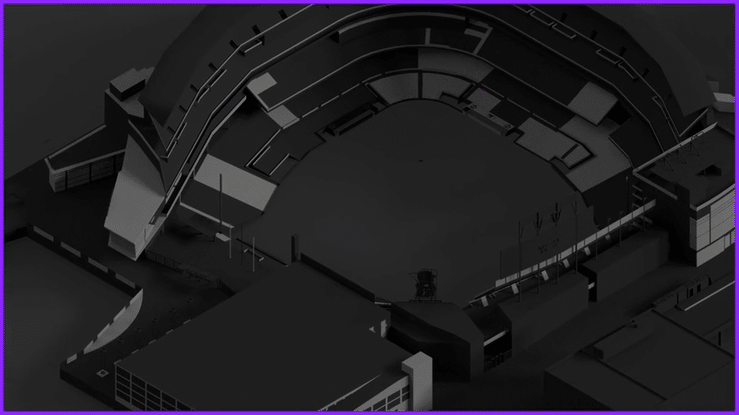
Creating Shared Social Experiences
Let’s be honest: while fans may be physically captive, of a sort, at in-person sporting events, it’s another game to capture and keep their attention. At the same time, sports is inherently social – something that positions it well to beat the AR trap of failing to scale by being mired in individual experiences. Leveraging AR to extend shared moments through every part of the game will help build closer connections between teams, players, and their fans, bringing talent on the field to life in multi-sensory, bigger-than-life arenas.
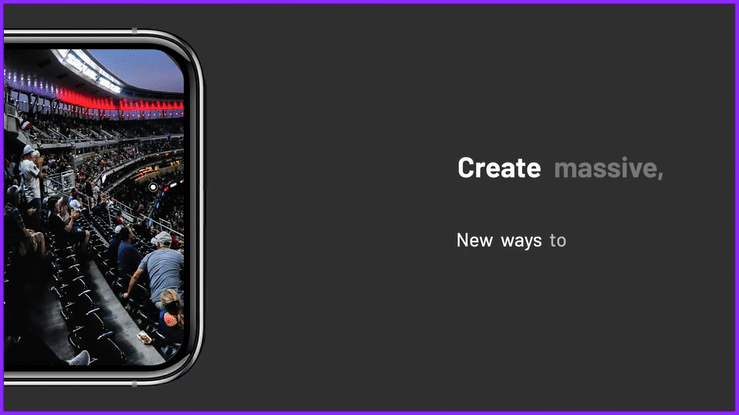
Layering gamified content, player stats and optional replays in AR during games can keep fans focused on and interacting with the field. Brands might stoke team rivalries with interactive competitions during games, with fans’ actions contributing to an aggregate team score. At the end of a game, fans from the winning team might get virtual collectibles or NFTs that build up to larger prizes with more and more engagement at AR-enabled locations, ultimately winning season passes or exclusive IRL merchandise. During intermissions, fans could open their phones to participate in competitions like tug of war fueled by the in-app engagement of 30,000 people, with rival team mascots scaled as AR avatars on the field. You can even imagine beloved mascots like The Phillie Phanatic or Mr. Met swarming the field with AR-doubles for intermission shows that extend beyond the physical to engage fans throughout the entire stadium, not just close to the field.
While our focus is ostensibly on AR moments connected to physical locations and powered by mobile, it’s not hard to see how marketers can activate AR-integrated apps or hardware to plug at-home fans into live sports.
Related
Articles
Investments & Financials, Press Releases
May 08, 2024
Stagwell Inc. (STGW) Reports Equity Inducement Grants Under Nasdaq Listing Rule 5635(c)(4)
Stagwell Inc. announced today the grant of equity inducement awards.
Data, In the News, Press Releases
May 07, 2024
New Study by Stagwell’s (STGW) The Harris Poll: New Yorkers are Worried about the Waste Crisis but Don’t See a Plastic Ban as a Solution
Survey found that plastic plays an important role in the…
In the News, Press Releases, Stagwell Marketing Cloud, Talent & Awards
May 06, 2024
PRophet, a Stagwell (STGW) Company, Takes Home Two Big Wins at the 2024 Innovation SABRE Awards and 28th Annual Webby Awards
PRophet's AI-driven platform clinches two prestigious awards for innovation and…
Newsletter
Sign Up
FEATURING
As we reflect on the marketing implications of CES 2022, Web 3.0 is by far the most impactful development that showed up across industries, technologies and capabilities. While in some ways it may be another victim of CES’ shiny veneer versus reality, there are components that are impossible to ignore – namely, the influx of and investment in the metaverse and NFTs.
Stagwell is one of the first movers when it comes to helping brands activate in this nacent space, having supported the launch of MilkPeP’s activation in the Roblox metaverse. On Thursday, January 6, Stagwell convened a lunch and learn, moderated by Axios’ Sara Fischer, to discuss the tactical and theoretical challenges and opportinities presented by Web 3.0. Here are our top 5 takeaways from the conversation:
- COVID WAS A CATALYST, bringing the metaverse into the real world
- BRANDS WILL PLAY A KEY ROLE IN BUILDING TRUST with these technologies and platforms
- NOT EVERY BRAND SHOULD BE IN THE METAVERSE, and not every metaverse is created equal
- METAVERSE + IRL should be a seamless experience
- NFTS are here to stay
Web 3.0 is a nuanced topic, and one that is the opposite of a one-size-fits-all approach. Depending on brand, product, buyer demographic and existing marketing activity, the metaverse and NFTs can fill a very important role (which may be… no role at all. More on that later). Learn more about what it means for brands, creative and the future of the online/offline world.
Praesent rutrum gravida consectetur. Cras vitae pretium urna. Phasellus aliquet, lacus dictum consequat tempor.
1. COVID was a catalyst, bringing the metaverse into the real world
The metaverse would have come eventually (in fact it’s already been here…hello, gaming community!), but the pandemic undoubtedly accelerated the timeline. With the majority of the world going digital, tech companies were pushed to develop products, tools and software that allowed us to do so much more from a virtual setting, exposing a more urgent demand for expanded virtual experiences and capabilities from brands.
the role of brands, as it has always been, is to create culture and pioneer what could be coming and help people imagine the art of the possible. They create links for consumers and act as educators for navigating the new space.
2. Brands will play a key role in building trust with these technologies and platforms
|
There’s a significant opportunity to live your brand values in the metaverse. If done well, brands will ensure their presence is connected and consistent with the way they show up in the real world, ultimately leading to greater consumer loyalty and retention. |
3. Not every brand should be in the metaverse, and not every metaverse is created equal
|
Direct-to-consumer relationships are more important than ever as we move into a cookieless world, so there are real business reasons that support having a presence in the metaverse. But it comes down to understanding your brand’s role, identifying your objectives, and how entering this space would aid in achieving those, and finally, implementing a process for facilitating, tracking, and measuring success. |
4. Metaverse + IRL should be a seamless experience
|
Let’s face it, some consumers are nearing a point of digital saturation. So, it’s important to note that the metaverse is not meant to be all-consuming. People value in-person experiences – there will be points in time that make sense to utilize the metaverse in addition to other consumer touchpoints, while there will be moments where we can come together in the real world and physically be a part of something. Blending the two seamlessly: now that’s a real win. |
5. NFTs are here to stay
|
As these advancements become more democratized in their accessibility, brands will start to use them more, whether it’s for loyalty, or to reignite an old concept or product. Industries will adopt NFTs as a creative means to build community and connect with people who support and protect their brands. |
Originally released on
CONTACT
Lorem Ipsum
FEATURING
Related
Articles
Investments & Financials, Press Releases
May 08, 2024
Stagwell Inc. (STGW) Reports Equity Inducement Grants Under Nasdaq Listing Rule 5635(c)(4)
Stagwell Inc. announced today the grant of equity inducement awards.
Data, In the News, Press Releases
May 07, 2024
New Study by Stagwell’s (STGW) The Harris Poll: New Yorkers are Worried about the Waste Crisis but Don’t See a Plastic Ban as a Solution
Survey found that plastic plays an important role in the…
In the News, Press Releases, Stagwell Marketing Cloud, Talent & Awards
May 06, 2024
PRophet, a Stagwell (STGW) Company, Takes Home Two Big Wins at the 2024 Innovation SABRE Awards and 28th Annual Webby Awards
PRophet's AI-driven platform clinches two prestigious awards for innovation and…
Newsletter
Sign Up
Originally released on
by Justin Crann
CONTACT
Beth Sidhu
FEATURING
ARound aims to help brands turn augmented reality from an individual to a communal experience.
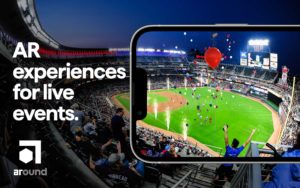
At CES this week, holding company Stagwell debuted a new augmented reality technology it believes will provide a low-barrier entry for many brands and marketers into the metaverse.
The technology, called ARound, is a platform that eschews the often highly individualized AR experience and instead seeks to open it up, allowing venues and retailers to create attractions in the virtual space for their live events, better capturing guests’ attention, personalizing their experiences and increasing brand engagement.
“The purpose of ARound is to change augmented reality from something you do alone in a room with a headset into something you can do as a shared experience, because we believe the most effective experiences for brands, marketers and advertisers are those that are experiential, persistent and shared,” explains Beth Lester Sidhu, chief brand and communications officer with Stagwell.
The technology allows venues, retailers, and others with large spaces that would typically see plenty of traffic to capture that space, build an AR version of it, and then layer different experiences – such as games, direct purchasing, and other interactive elements – on top of it.
As an example, Sidhu cites the MLB mascot race, which typically involves a limited number of participants on an actual baseball field between innings. Rather than being limited to physical space and a small number of participants, teams – including an unnamed franchise which is already employing the ARound platform – can open the experience up to many more participants. H&M was also among the retailers involved in a test conducted last year.
While the applications for the platform are “tremendous,” says Sidhu, “there’s a lot of education.”
“Clients are interested in the product and how they can use it,” she explains. “Marketers want to be at the forefront of what is interesting to consumers, and consumers are excited about AR. But it is hard for most brands to figure out how to play in the space.”
While ARound isn’t a turnkey solution, it is “a scalable way for brands to interact with AR with relative ease and without spending millions of dollars.”
“The power of ARound is in connecting our physical spaces with AR. If we bring those two things together, we can create amazing opportunities for brands, consumers and marketers – really, anybody who wants to be at the forefront,” says Sidhu.
ARound is part of the broader Stagwell Marketing Cloud, which was fully unveiled at CES this year. A suite of integrated SaaS products, it also includes Harris Brand Platform, which provides daily insights on KPIs like brand perception, equity, sales funnels and the impact of marketing campaigns on customer behavior and perceptions; Koalifyed, an end-to-end influencer marketing application; and PRophet, a PR application that uses AI to predict media interest, sentiment and spread of a press story prior to pitching.
Related
Articles
Investments & Financials, Press Releases
May 08, 2024
Stagwell Inc. (STGW) Reports Equity Inducement Grants Under Nasdaq Listing Rule 5635(c)(4)
Stagwell Inc. announced today the grant of equity inducement awards.
Data, In the News, Press Releases
May 07, 2024
New Study by Stagwell’s (STGW) The Harris Poll: New Yorkers are Worried about the Waste Crisis but Don’t See a Plastic Ban as a Solution
Survey found that plastic plays an important role in the…
In the News, Press Releases, Stagwell Marketing Cloud, Talent & Awards
May 06, 2024
PRophet, a Stagwell (STGW) Company, Takes Home Two Big Wins at the 2024 Innovation SABRE Awards and 28th Annual Webby Awards
PRophet's AI-driven platform clinches two prestigious awards for innovation and…
Newsletter
Sign Up
ARound brings interactive shared experiences to the metaverse.
NEW YORK, Dec. 16, 2021 /PRNewswire/ — Stagwell Inc. (NASDAQ: STGW) announced today it will launch an innovative, location-based augmented reality platform, ARound, bringing shared experiences to live events and the retail space by engaging audiences through connected interactions in the metaverse. Stagwell will unveil and demo ARound at CES 2022, within its CES booth #CS-10 in the C-Space at Aria and during CES Unveiled on January 3 at Mandalay Bay and Pepcom Digital Experience on January 4 at The Mirage.
ARound helps venues and retailers create AR attractions for live events, bringing audiences together at scale where they can play, interact, and socialize in completely new and exciting ways. Stadiums and sports teams can now engage casual fans or customers by recapturing their attention and personalizing their experiences. Retail consumers will benefit from a more connected, immersive community experience that increases brand engagement.
“Until now, AR has focused on the individual – but ARound recognizes that the best connections come from shared experiences that connect individuals to the world around them,” said Josh Beatty, ARound founder and CEO. “Location-based AR is a relatively new and evolving space, and spatial computing represents the next major computing innovation – one that will focus less on the way we receive information and more on the way we connect with what is around us. While devices often cause distraction, ARound enables users to be more present at events, connecting people and places through shared technology.”
“Consumers have lost patience for boring, impersonal, and disconnected marketing. And the race for their attention in today’s digital marketplace couldn’t be tighter,” said Mark Penn, Chairman and CEO, Stagwell. “ARound offers clients an opportunity to chart a new course in a powerful – and fast growing – dimension of consumer experiences. We’re proud to support Josh as he works to bring the product to life,” said Mark Penn, Chairman and CEO, Stagwell.
ARound is currently being trialed by global retailer H&M, as well as a Major League Baseball team at their stadium. More partners will be announced early next year.
ARound is the newest product from the Stagwell Marketing Cloud, Stagwell’s growing suite of technology products and services that support business transformation for modern marketers. It was developed as the winning idea at Stagwell’s annual innovation competition, which challenges teams to pitch new product ideas to modernize marketing services and pre-empt the needs of tomorrow’s leading brands. As a winner, ARound received capital and resources from Stagwell to build and launch the product as well as ongoing executive mentorship from the company’s marketing and technology services leaders.
Stagwell Marketing Cloud – powered by a global workforce of 1000+ engineers – arms modern marketers with a toolbox of capabilities spanning influencer marketing, audience segmentation, AI-powered communications tech, competitive brand intelligence and cutting-edge technology in the developing spaces of AI, ML, AR/VR, data processing and fraud detection. Stagwell’s products include Koalifyed, CUE, PRophet, Harris Brand Platform, Telephia, Truly Social, Stage, and Navigator.
To schedule a product demo of ARound at Stagwell’s CES booth, #CS-10, contact (brand@stagwellglobal.com). To schedule a media interview with AR founder, Josh Beatty, contact Pam Golden at pam@GLAPR.com.
About Stagwell Inc.
Stagwell is the challenger network built to transform marketing. We deliver scaled creative performance for the world’s most ambitious brands, connecting culture-moving creativity with leading-edge technology to harmonize the art and science of marketing. Led by entrepreneurs, our 10,000+ specialists in 20+ countries are unified under a single purpose: to drive effectiveness and improve business results for their clients. Join us at www.stagwellglobal.com.
Media Contact
Beth Sidhu
beth.sidhu@stagwellglobal.com
202-423-4414
SOURCE Stagwell Inc.
Related
Articles
Investments & Financials, Press Releases
May 08, 2024
Stagwell Inc. (STGW) Reports Equity Inducement Grants Under Nasdaq Listing Rule 5635(c)(4)
Stagwell Inc. announced today the grant of equity inducement awards.
Data, In the News, Press Releases
May 07, 2024
New Study by Stagwell’s (STGW) The Harris Poll: New Yorkers are Worried about the Waste Crisis but Don’t See a Plastic Ban as a Solution
Survey found that plastic plays an important role in the…
In the News, Press Releases, Stagwell Marketing Cloud, Talent & Awards
May 06, 2024
PRophet, a Stagwell (STGW) Company, Takes Home Two Big Wins at the 2024 Innovation SABRE Awards and 28th Annual Webby Awards
PRophet's AI-driven platform clinches two prestigious awards for innovation and…
Newsletter
Sign Up
Whether you’ve been here for four months or 14 years, the defining characteristic has always been creativity
Related
Articles
In the News, Press Releases, Stagwell Marketing Cloud, Talent & Awards
May 06, 2024
PRophet, a Stagwell (STGW) Company, Takes Home Two Big Wins at the 2024 Innovation SABRE Awards and 28th Annual Webby Awards
PRophet's AI-driven platform clinches two prestigious awards for innovation and…
Augmented Reality, In the News, Marketing Frontiers
Apr 26, 2024
Legacy Brand, Meet Next-Gen Commerce: Bomb Pop Takes Roblox
Bomb Pop is the most popular ice pop that nobody…
Artificial Intelligence, In the News
Apr 25, 2024
Embracing Comfort Unapologetically with First-Ever AI-Powered La-Z-Boy ‘Decliner’
Building the first-ever AI-powered recliner for the brand that invented…




